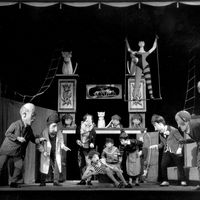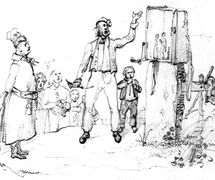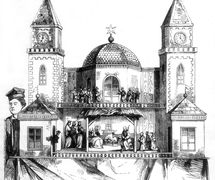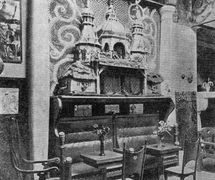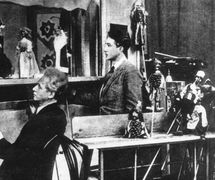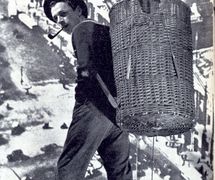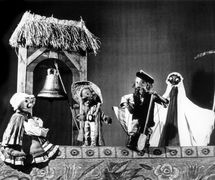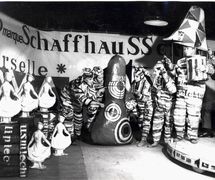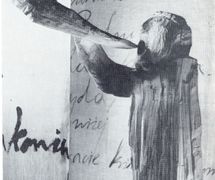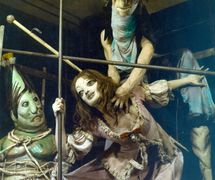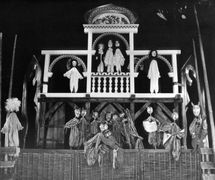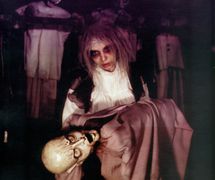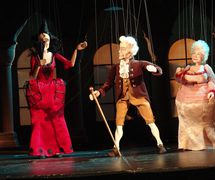Officially the Republic of Poland (Polish: Rzeczpospolita Polska), Poland (Polska) is located in Central Europe and is bordered by Germany to the west, the Czech Republic and Slovakia to the south, Ukraine, Belarus and Lithuania to the east, and the Baltic Sea and the Russian exclave Kaliningrad Oblast to the north. In the 20th century, the country regained its independence in 1918 after 123 years of the Partitions of Poland between Russia, Prussia and Austria; from 1945 to 1989, it became allied to the Soviet Union as the People’s Republic of Poland.
Puppetry in Poland
Puppet theatre has existed in Poland for at least five centuries. The first documentary evidence dates from the 15th century and mentions a performer from Vilnius named Waśko, who travelled alongside certain merchants with his puppet shows (lothki, łątki). He may well have been one of those artists of the popular theatre (skomorokh) in the Slav countries who not only exhibited their figures but also were already giving performances. Their presence could not have been easily ignored, since in the works of certain prominent Polish writers of the 16th century, notably Mikołaj Rej and Jan Kochanowski, the puppet and the puppet theatre figured in poetic analogies and metaphors – especially the recurring image of the puppet which evokes laughter whenever the player or jongleur wishes it.
Itinerant Puppeteers
Comic business and badinage evolved in the 16th century theatre through the influence of foreign puppeteers (see Itinerant Troupes, Travelling Puppeteers). In 1506 an Italian, the “Magister de Omnibus Sanctis” (Master of All Saints) presented his Tabernacula cum personis (literally, cabinet with figures) to Prince Sigismund in Cracow (Kraków). At the end of the century, some Dutch and German puppet players (Henrik Janson, Andreas Rothe, Friedrich Hune) gave performances of a “mechanical theatre” in Gdansk (Gdańsk). At first they were mystery plays, but of profane content, influenced by the example of English actors and puppeteers. The troupes playing in Poland, particularly in the first half of the 17th century, enjoyed the support of the Court of Sigismund III Vasa, then of Ladislas IV. The first mention of commedia dell’arte Italian actors who also included puppet players appear in the middle of the 17th century (notably in 1666 at the court of Jan Kazimierz in Warsaw Warszawa). Johann Peter Hilverding (father of the famous puppeteer Johann Baptist Hilverding), active in Silesia in the second half of the 17th century, made a speciality of Pulcinella shows; see Hilverding (family). His choice was imitated by Daniel Ernest Carcerius, among others. It was these foreign puppeteers who led the field throughout Europe in the 17th century: the repertoire included mechanical theatres and marionettes performing mystery plays, myth and opera.
Apart from a few instances, such as a łątek comedy given in Gdansk in 1672, little is known of the Polish puppeteers of the period. Like their foreign colleagues, above all the Germans and Italians, they were a part of the international comings and goings of the showmen, travelling as far as Moscow (like the Jakubowski family in the first half of the 18th century) or Spain (like Felix Kinsky in the 1740s). It would appear that, in the second half of the 17th century, the art of the Polish puppet theatre was invested in the companies which specialized in the szopka or performances of the Christian “Nativity” (see also Nativity Scenes).
The 18th Century
In the mid-18th century some puppet companies specializing in opera and lyric pieces appeared in the residences of the Polish aristocracy: the most famous was established in Biała Podlaska and in Słuck between 1753 and the 1760s by Prince Hieronim Radziwiłł, under the direction of one Helman. In contrast to the humble wandering troupes, their shows included many artistically sculpted and finely costumed puppets, clever lighting and a fine collection of stage machinery which allowed changes of setting in full view with many special effects. Prince Michał Radziwiłł also boasted a theatre for puppets in his Nieśwież residence, as did the military commander (hetman) Jan Klemens Branicki in Bialystok (Białystok).
In the second half of the 18th century puppet shows multiplied in Poland, probably due to the support offered them by Stanislas (Stanisław) August Poniatowski, the last king of Poland, sympathetic to the arts in general including puppetry to which he gave generous donations. He attended the ever growing number of puppet performances, some given in large public spaces. The German-speaking Gerhard Bressler was, at the end of the 18th century, the most celebrated puppeteer in Poland, often performing in great cities which became the model for such shows until the late 19th century. His programmes consisted of a principal piece with a central comic character (Pimperle in his case) who played in various guises and roles, giving rise to all sorts of ingenious effects and interactions with other characters; next some transformations, followed by a comedy in one act which concluded with a firework display, or a short musical piece executed by the family of the puppeteer-producer.
A painting by Jan Piotr Norblin, The Polish Puppets (end of the 18th century), constitutes the first known iconographic document of the Polish puppet theatre; the manipulators are holding by their controls figures of the marotte type, their hands resting on the booth‘s playboard (the narrow frontal stage) in front of a two-dimensional representation of Warsaw’s old town. A puppeteer known to be active among the players of the time was Barani Kożuszek who, apparently inspired by the patriotic circles of Warsaw (Poland was at that time under the rule of three occupying powers: Russia, Prussia and Austria), staged with the aid of a miniature guillotine the beheading of certain “enemies of the people”.
The 19th Century
During the first half of the 19th century the toy theatres (also called paper theatres; consisting of series of printed scenery and figures) made their appearance alongside the companies which were spread across Poland. From the end of the 18th century the public favoured the mechanical theatres which presented either immobile figures or figures moved mechanically against a flat or specially made painted background, in which the movement was by means of cogs or wheels (theatrum mundi). Among the practitioners of this art, Polish as well as foreign, were Antoni Wolski and Christian Tschuggmall; but the most famous was Jordaki Kuparenko, who followed a career in mechanics up to his death in 1844. The popularity of these shows was owed to their intricate technology, but their attraction faded when the secrets and the limitations of the workings of these automata were discovered. One might believe that the period resulted in the eclipse of the puppet by the automaton, but this belief must be moderated by the fact that many puppet showmen were simply adding mechanical items to increase the attraction of their puppets.
Among the itinerant foreign companies there were distinguished Polish companies such as that of Józef Bogacki who, after service in the army, gained the right in 1812 to be the director of a puppet theatre in Cracow. As usual, this “right” was hedged by many official restrictions: no music, the obligation to finish the show before the service of Vespers, sometimes the imposition of a tax to be paid to the classical theatres for whom the “lowlife” puppets were a serious competition. This proved to be the case when the success of the marionettes of the brothers Dennebeq (French) threatened the interests of the Polish National Theatre.
At the end of 1843 a permanent puppet company was established in Warsaw, where they gave daily performances of shows including Hans wesoły partacz (Jolly Good-for-nothing Hans), Miłość na próbie (Love on Trial), but it was open for no more than a month. Theatre with puppets started to lose its attraction from the beginning of the 19th century. It received new life when it left the big cities with their grand halls and sought a public in the suburbs and outskirts where the shows were played in specially constructed theatres or barraques. This state of affairs was largely due to the puppeteers themselves, to their conservative tastes and their loyalty to the old techniques and the traditional repertoire.
Among the more active entrepreneurs of this time were Fryderyk Siegmann and a certain Żulicki, but at the end of the century it was the foreign marionettists, using mainly string puppets, who dominated the Polish scene. From the 1870s showmen using glove puppets in the manner of the Viennese Kasperltheater began to appear on the streets.
Beginning of the 20th Century
A renewal began to be felt at the beginning of the 20th century, when intellectual circles realized the educational potential of the puppet theatre for a young public. Writers, journalists and educationists joined the ranks of those who militated in its favour. An early theatre for children, founded in Warsaw by Władysław Rybka, combined puppets with other attractions: optical illusions, magic tricks and tableaux vivants. The first theatre for children entirely dedicated to puppets was the work of Maria Weryho-Radziwiłłowicz in 1900-1904. Her example was followed in 1903 by Stefania Boima-Wachowska in Cracow, also by Adam Setkowicz and Józef Rączkowski in 1911 in Cracow and by the Krasnoludek (Lutin) theatre in 1916 in Warsaw. Their common model was the theatre of “Papa Schmid” (see Josef Leonhard Schmid) in Munich, but it was another model, Paul Brann‘s avant-garde Marionettentheater Münchner Künstler (Marionette Theatre of Munich Artists), which provided the inspiration for the company founded by Marian Dienstl-Dąbrowa in 1910.
Just as these groups had nothing in common with the itinerant showmen, the szopka performances hardly resembled the traditional Christmas shows. A “satirical” szopka (also known as a literary, artistic or political szopka), born in the Zielony Balonik (The Green Balloon, a Cracow cabaret) became a genuinely Polish genre that enjoyed an unprecedented vogue between the two world wars. It evolved into two distinct satiric styles, one which revived the model of the Christmas szopka, and one which abandoned all tradition, becoming nearer to the puppet performances inaugurated in 1909 by the Momus cabaret in Warsaw.
Poland regained its independence in 1918, when the puppet theatre regained its strength. The 1920s witnessed the arrival of great artists who, no longer worried by the risk of failure, gave themselves completely to the puppet theatre. Stefan Polonyj-Poloński toured the productions of his company Miniatury to Cracow, Katowice and Poznan (Poznań) from 1927 to 1939. In 1928 the puppeteers of the Warsaw Baj theatre harnessed their enthusiasm to an educational programme under the direction of Jan Wesołowski. A major contribution was made by the Italian puppeteer Vittorio Podrecca (see Teatro dei Piccoli) who toured the principal cities of Poland in 1928, 1930 and 1936. On the instigation of Jan Izydor Sztaudynger, the puppeteers started to organize themselves as a group, and in 1938 the Wielkopolska Rodzina Marionetkarzy (The Community of Puppeteers of the Region Great Poland), composed of the professionals from the Poznan and Pomeranian regions, was founded in Poznan. The same year the association was given a permanent theatre, the Błękitny Pajac (Blue Clown) and, through Jan Sztaudynger, a periodical: Bal u lal (Ball at the Puppets). Also to Sztaudynger can be credited the creation of a movement towards the professionalization of the puppeteers, and to the Baj theatre under Jan Wesołowski the promotion of puppetry for educationists as for children, together with a surge in the current of amateurs. One such puppet theatre was established in 1937 in the Polish community of Opole (Upper Silesia, now in southern Poland) by Alojzy Smolka – the Opolski Teatr Lalki i Aktora im. Alojzego Smolki (Alojzy Smolka Puppet and Actor Theatre). These efforts, blocked by the war years, nonetheless bore fruit after it was over.
World War II once more erased Poland from the map of Europe. Occupied in almost equal parts by Nazi Germany and the Soviet Union, it was forced to form its own clandestine political, military and cultural structures. A semblance of activity was maintained in the Soviet zone by the puppet theatres of Władysław Jarema and Zofia Jaremowa in Grodno and by the children’s theatre of Młodego Widza (Youth Theatre), active until 1941 in Vilnius. Some coordinated activity was undertaken in the German-occupied zone. The Germans would give sporadic permission for the opening of a company, notably the Figlarny Kubuś (Playful Little Jacob) for children in 1940, and the Hulajnoga (Scooter) which played revues for adults in 1943, both in Warsaw, and in Cracow the puppet theatre of Marian Mikuta in 1944. But the vast majority of the shows were underground. Puppet theatre proved capable of evoking the Polish past (through the szopka shows), of inciting small acts of sabotage, and of substitution for the human theatre. In private apartments dozens of puppet shows were shown over the years; even in prisons and concentration camps where the Poles were incarcerated (Dachau, Ravensbrück, Auschwitz and Buchenwald), shows were organized. All over Europe, in prison camps for officers (Oflags) or soldiers (Stalags), performances were given: some by groups of the officers of Oflag VIIA in Murnau and Oflag IIC in Woldenberg, from 1941 up to their liberation in 1945. Wherever there were Polish soldiers in combat, from the Middle East to Great Britain, puppet programmes were to be found.
The Soviet Era
After the war Poland remained a Soviet satellite for nearly fifty years and the Soviets imposed their methods and principles on the culture of the country. The re-emergence of the puppet theatre was at first the work of the pre-war and wartime artists: the Jarema couple, Henryk Ryl, Janina Kilian-Stanisławska, Irena Pikiel, Joanna Piekarska, Tadeusz Czapliński, Jerzy Zitzman, Marta Janic all of whom created private, semi-professional groups, partly subsidized. Władysław and Zofia Jarema took a leading part in the movement, founding the Groteska theatre in Cracow in 1945, as did Henryk Ryl, founding the Arlekin theatre of Lodz (Łódź) in 1948. Janina Kilian-Stanisławska (see Lalka) founded the Teatr Lalek Niebieskie Migdały (literally: Blue Almonds Puppet Theatre; figuratively: Castles in the Sky Puppet Theatre) in Samarkand in 1945, relocating to Warsaw in 1948, and Irena Sowicka created the Guliwer company, also in Warsaw, in 1946. The first productions – Cyrk Tarabumba (Tarabumba Circus) by the Jaremas, Kolorowe piosenki (Many-coloured Songs) by Henryk Ryl, and Guliwer w krainie Liliputów (Gulliver in Lilliput) – defined the subjects and the artistic practice of the puppet theatre for many years. With the support of a vast pool of amateurs this kernel of artists began to build the profession of puppeteer, taking its place in such professional bodies as the Society of Polish Theatre and Cinema Artists, organizing training in the department of puppetry of the Ludwik Solski State Higher Theatre School in Cracow, founded in 1954, revising the criteria for a professional qualification, and initiating the publication of the revue Teatr Lalek.
The establishment of the State Theatres
At the turn of the 1940s and 50s, Poland was forced to adopt the model of a State Theatre dedicated to young people, just as Sergei Obraztsov had founded in Moscow in the 1930s. The Polish theatres were nationalized in 1950 – Groteska in Cracow, Arlekin and Pinokio in Lodz, Guliwer and Lalka in Warsaw, Banialuka in Bielsko-Biala (Bielsko-Biała), Baj Pomorski in Torun (Toruń) and Miniatura in Gdansk – and installed in their own buildings with their own workshops and teams of artists, technicians and administrators, comprising dozens of people. The numbers of these permanent site theatres, about a dozen in the 1950s, had swollen to 27 by the end of the 70s. The supervision of the State on the one hand promoted the profession of puppetry but on the other hand limited the independence of both artists and companies. The appointment of directors and artists had to be approved by the Ministry of Culture or its representatives, and the reports and accounts which the companies had to submit were complicated enough to discourage any artist.
However a certain financial freedom, although limited by a strict budget, allowed the theatres to focus their efforts on artistic matters. From the middle of the 1950s Polish puppetry assumed its own original style, once again indebted to the efforts of Groteska, Arlekin and of Lalka which gained an international reputation in the first international festival in Bucharest, Romania, in 1958: Lalka was awarded the gold medal for Guignol w tarapatach (Guignol in Trouble) directed by Jan Wilkowski; silver medals were won by Groteska’s staging of Wieczór Gałczyńskiego (Gałczynski Soirée) and the scenography of Arlekin’s Kolorowe piosenki (Many-coloured Songs). These successes before an international public proved especially beneficial to two young artists: Jan Wilkowski and Adam Kilian. The two collaborated on a work now regarded as a supreme example of the Polish style: O Zwyrtale muzykancie, czyli jak się góral dostał do nieba (Zwyrtała the Musician, Or How the Tatra Highlander Got to Heaven, 1958). Polish puppetry adopted a style which favoured the interpretation of literary works by means of a pure scenography imagined by great designers – notably Kazimierz Mikulski, Jerzy Skarżyński, Ali Bunsch, Adam Kilian, Zenobiusz Strzelecki, Leokadia Serafinowicz, Wacław Kondek – who perceived in this theatre a space where they could freely realize their artistic conceptions. This was well demonstrated during the 8th Congress of UNIMA, which took place simultaneously with an international festival of puppet theatres in Warsaw in 1962.
A new generation
In the 1960s the companies were taken in hand by other artists, actors turned directors, such as Leokadia Serafinowicz, Krzysztof Niesiołowski, Stanisław Ochmański, Monika Snarska, Zygmunt Smandzik, Jerzy Kolecki, Leszek Śmigielski, all formed by the post-war artists before them. They inherited a certain style, bringing with them a knowledge of acting and manipulating techniques, as well as the ambition to make a mark with their own artistic conceptions. This was the time when the Miniatura of Gdansk and Marcinek of Poznan (see Teatr Animacji w Poznaniu, Theatre of Animation of Poznan) united to become one of the foremost puppet theatre companies of Poland. Jan Dorman, director of Teatr Dzieci Zagłębia (the Children’s Theatre of the Zagłębie region) in Bedzin (Będzin), established and continued to confirm their role as chief experimenters and enfant terrible of the puppet world. Major towns welcomed puppet festivals (Opole, Bielsko-Biala with its Banialuka theatre), which could be regional or specialized (the festival of Torun featured companies from northern Poland; the festival of eastern Poland was held by turns in Lublin, Rzeszow Rzeszów, Bialystok, and Kielce; the festival of solo work in Warsaw).
The theatres initiated a policy of cooperation and exchange with those of other countries, taking part in meetings and international festivals, so integrating Poland into the worldwide family of puppetry. The efforts made by Henryk Zdzisław Jurkowski, then director of the puppet theatre department in the Ministry of Culture and an active promoter of the international structures of UNIMA, were a determining factor in this development.
A new generation – Andrzej Dziedziul, Krzysztof Rau, Wiesław Hejno, Wojciech Wieczorkiewicz, Włodzimierz Dobromilski, Zofia Miklińska – entering the profession in the same way as their predecessors, led the Polish puppet theatre until the turn of the 1960s and 70s, while the Small Stage of the Wrocławski Teatr Lalek (WTL, Wroclaw Puppet Theatre), dedicated to adult work, and the Studium Aktorskie Teatrów Lalkowych (SATL, Actors’ Studio for Puppet Theatres), also of Wroclaw, both joined the companies of the first rank.
The puppet theatre of Wroclaw and that of Bialystok (Białostocki Teatr Lalek [lier]Bialystok Puppet Theatre[/lier]) were regarded as among the leading puppet theatres of the 1970s and 80s, especially after the creation of university-level courses in the middle of the 1970s and the obvious rivalry between the Wydział Lalkarski we Wrocławiu (Faculty of Puppet Theatre in Wroclaw) and the Akademia Teatralna w Białymstoku (Theatre Academy of Bialystok). The generation of directors trained in the Soviet Union and in Czechoslovakia – Wojciech Kobrzyński, Tomasz Jaworski, Konrad Szachnowski, Irena Dragan, Włodzimierz Fełenczak – were also distinguished in the 1970s.
The 1980s brought upheaval, above all for the performer-puppeteers. The old masters – notably Juliusz Wolski, Tadeusz Wojan, Zdzisław Owsik, Teresa Sawicka, Krystyna Cysewska, Krystyna Matuszewska, Jan Plewako, Anna Proszkowska, Tomasz Brzeziński – were replaced by the young graduates from the puppet schools where they had been thoroughly trained. From a more formal point of view, the stage screens, omnipresent until then, gave way to a combination of expressive techniques where the actor-manipulator was in front, in full view. Some new and very capable artists joined the puppet theatres as scenographers, such as Jadwiga Mydlarska-Kowal, Rajmund Strzelecki and Mikołaj Malesza.
The new generation of company leaders (who had replaced the earlier generation of scenographers and directors) were artists who had graduated from the schools, and very often the actors, too, notably Małgorzata Kamińska, Grzegorz Kwieciński, Bogdan Nauka, Zbigniew Niecikowski, Zdzisław Rej, Czesław Sieńko, Wojciech Szelachowski, Maciej K. Tondera, Waldemar Wolański, Aleksander Antończak, Piotr Tomaszuk. Their playful or ironic use of the conventions, their recourse to a wide range of expressive means nevertheless included an ability to engage with the literary puppet theatre inherited from their predecessors.
The Contemporary Era
Came the upheavals of the 1990s. The Soviet system, from the end of the 1970s only a façade as far as the puppet theatre was concerned, survived in the official sector of the arts. Some private theatres established in the 80s continued: Teatr Wierzbak in Poznan, the Theatre of Fire and Paper of Grzegorz Kwieciński. In this category were Wierszalin, Theatre ¾ Zusno directed by Krzysztof Rau, and Tadeusz Wierzbicki’s Company of the Little i (later, Laboratory of Appearances), each bringing a new and original style of performance (the relationship of puppet and actor, bare hand manipulation, experiments with shadows and electrostatic fields). Later there appeared the following companies: Walny-Teatr, Unia Teatr Niemożliwy (Impossible Theatre Union), Teatr K3, Kompania Doomsday (divided into Teatr Malabar Hotel and Grupa Coincidentia), which continue to thrive. For various reasons, however, in particular the lack of receiving venues, independent companies tended to have a short life. Thus, at the beginning of the 21st century, the activities of the Polish puppet theatres were concentrated around the official theatres (municipal or regional).
Institutions
The Polish centre of UNIMA, POLUNIMA, was founded in 1961 by Henryk Ryl. In 2005, it was headed by Henryk Jurkowski and, in 2015, by Waldemar Wolański. Separately there has been, since 1950, a puppetry section of the Association of Polish Theatre Artists (ZASP).
Museums
In addition to the Department of Puppetry of the Archaeological and Ethnographic Museum of Lodz – Muzeum Archeologiczne i Etnograficzne w Łodzi, Dział Widowisk Lalkowych (Łódź Museum of Puppetry) – there is also the Seweryn Udziela Museum of Ethnography in Cracow. This owns twenty-three szopka of which one is the oldest known to exist, made by Michał Ezenekier in the second half of the 19th century. There are also about 650 szopka figures which are dated up to the end of the 19th century.
The National Museum of Ethnography in Warsaw, created in 1888, has a regional, European and international collection of artefacts, including nine szopka and their puppets dating from the early 20th century up to the 1980s.
(See also Tadeusz Kantor.)
Bibliography
- Jurkowski, Henryk. A History of European Puppetry. Vol. 1: From its Origins to the End of the 19th century. Lewiston: The Edwin Mellen Press, 1996.
- Jurkowski, Henryk. A History of European Puppetry. Vol. 2: The Twentieth Century. Lewiston: The Edwin Mellen Press, 1996-1998.
- Jurkowski, Henryk. “La formation des marionnettistes en Pologne” [Training Puppeteers in Poland]. Puck. No. 7. Charleville-Mézières: Éditions de l’Institut international de la marionnette, 1994.
- Jurkowski, Henryk. Métamorphoses. La marionnette au XXe siècle [Metamorphoses the Puppet in the 20th Century]. Charleville-Mézières: Éditions de l’Institut international de la marionnette, 2000. 2nd ed. revised and expanded. “La main qui parle” [The Hand that Speaks] series. Montpellier: L’Entretemps/Éditions de l’Institut international de la marionnette, 2008.
- Jurkowski, Henryk. Moje pokolenie. Twórcy polskiego teatru lalek drugiej połowy XX wieku [My Generation. Puppet Theatre Artists of the Second Half of 20th Century]. Łódź: POLUNIMA, 2006.
- Jurkowski, Henryk. “Teatr lalek w dawnej Polsce. Próba zarysu historycznego” [Puppet Theatre in Old Poland. An Historical Sketch]. O dawnym dramacie i teatrze. Studia do syntezy, Studia Staropolskie [On the Early Drama and Theatre.
- Studies in Synthesis, Early Polish Studies]. Vol. 31. Ed. W. Roszkowska. Wrocław: Ossolineum, 1971.
- Killian, Adam. “L’art populaire dans le théâtre de marionnettes” [Folk Art in the Puppet Theatre]. Pologne, théâtre et société. Exhibition catalogue. Neuchâtel: Musée d’Ethnographie, 1972.
- “Lalkarze. Materiały do biografii” [Puppeteers, Biographical Sources]. Collection directed by M. Waszkiel, 34 vols. Łódź: POLUNIMA and Pracownia Dokumentacji Teatru Lalek, 1993-2004; Białystok: BTL, 2009.
- Nessel-Łukasik, Beata. Oblicza samotności. Bruno Schulz, Franz Kafka i Samuel Beckett w polskim teatrze lalek [Faces of Loneliness. Bruno Schulz, Franz Kafka and Samuel Beckett in the Polish Puppet Theatre]. Kwidzyń: Scena Lalkowa im. Jana Wilkowskiego, 2012.
- Polakowski, Andrzej, and Marek Waszkiel, eds. Łódzkie sceny lalkowe [The Puppet Theatres of Łódź]. Łódź: POLUNIMA, 1992.
- Ryl, Henryk. Dziewanna i lalki [Dziewanna and Puppets]. Łódź: Wydawnictwo Łódzkie, 1967.
- Słownik biograficzny teatru polskiego [Biographical Dictionary of Polish Theatre]. Vol. 1 (1765-1965), Vol. 2 (1900-1980). Warszawa: PWN, 1973-1994.
- Sych, Honorata. Tajemnice teatru lalek [Secrets of Puppet Theatre]. Łódź: Muzeum Archeologiczne i Etnograficzne, 2010.
- Sztaudynger, Jan Izydor. Marionetki [Marionettes]. Lwów-Warszawa: Książnica Atlas, 1938.
- Sztaudynger, Jan Izydor, Henryk Jurkowski, and Henryk Ryl. Od szopki do teatru lalek [From the Szopka to the Puppet Theatre]. Łódź: Wydawnictwo Łódzkie, 1961.
- Waszkiel, Marek. Dzieje teatru lalek w Polsce (do 1945) [The History of Puppet Theatre in Poland (up to 1945)]. Warszawa: IS PAN, 1990.
- Waszkiel, Marek. Dzieje teatru lalek w Polsce, 1944-2000 [The History of Puppet Theatre in Poland, 1944-2000]. Warszawa: Akademia Teatralna im. Aleksandra Zelwerowicza, 2012.
- Waszkiel, Marek. “Szopka oder die keine Sabotage. Das polnische Puppen-Theater im zweiten Weltkrieg” [The Szopka, or the Little Sabotage. The Polish Puppet Theatre During World War II]. Frontpuppentheater, Puppenspieler im Kriegsgeschehen [Puppet Theatres at the Front, Puppeteers in Wartime]. Ed. D. Kolland. Berlin: Elefanten Press, 1997.
- Wiśniewska, Jolanta Ewa. W poszukiwaniu “złotego klucza”. Polska twórczość dramatyczna dla teatru lalek (1945-1970) [Searching for a “Golden Key”. Polish Dramas for Puppet Theatre (1945-1970)]. Łódź: POLUNIMA, 1999.
- 100 przedstawień teatru lalek. Antologia recenzji 1945-1996 [100 Performances of Puppet Theatre. Anthology of critics, 1945-1996]. Eds. L. Kozień and M. Waszkiel. Łódź: POLUNIMA, 1998.
- Bal u lal [Ball at the Puppets]. The first magazine devoted to Polish puppetry, founded and directed by Jan Sztaudynger, published monthly between 1938 and 1939 in Poznań. Of the seven publications, three were special issues on the themes of childhood, of puppet theatre in schools, and puppetry in the army. World War II put an end to the publication. (In Polish)
- Le théâtre en Pologne. Revue mensuelle du Centre Polonais de l’Institut International du Théâtre et de l’Agence des Auteurs / The Theatre in Poland. The Monthly Magazine of the Polish Centre of the International Theatre Institute and the Authors’ Agency, Warszawa. No. 5, 1962; No. 5, 1967; Nos. 1-2, 1969; No. 7, 1973; No. 12, 1974; No. 2, 1975; Nos. 8 and 21, 1979; Nos. 1-2, 1984. (In French and English)
- Pamiętnik Teatralny [Theatrical Diary]. Nos. 1-2. Warszawa: ISPAN, 1987. (On the Polish Puppet Theatre Before 1945; in Polish.)
- Teatr Lalek [Puppet Theatre]. Polish journal founded in 1950, and which appeared from 1950 to 1953 as an organ of the General Management of Puppet Theatres (CDTL), the State institution created to ensure the policy of the nationalization of theatres. It appeared again from 1957 to 1967 (under the direction of Henryl Ryl), from 1968 to 1970 (under the direction of Jerzy Koenig, then Henryk Jurkowski), and finally, since 1982, as the quarterly of the Polish UNIMA centre, POLUNIMA. Teatr Lalek has been bilingual (English and Polish) since 1995. Until 2000 the journal was led by Joanna Rogacka, since 2001 by Lucyna Kozień. See especially Nos. 1-4, 1969 (on Polish puppet theatre from 1944 to 1969) and No. 1, 1994 (on scenography, with a dictionary of designers).









